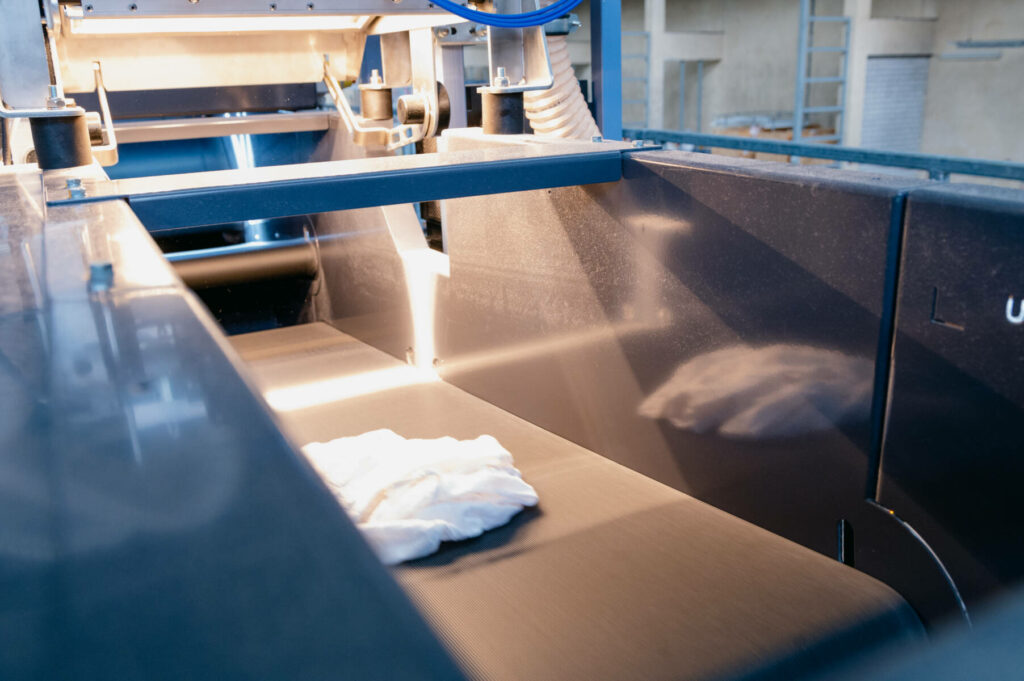
SOEX puts sorting station with material recognition into operation, solving a major industry problem
Wolfen, May 2022. SOEX has commissioned an infrared sorting station with material and color recognition at its plant in Wolfen-Bitterfeld. Through sorting accurately by material, SOEX intends to continue to focus on sorting for recycling – and drive up the recycling rate together with the fashion industry. An artificial intelligence recognizes the individual garments and can sort them by materials or colors. The final aim: pre-sorting for chemical recycling – to keep resources in the cycle. Using this technology, SOEX manages to determine the materials even more precisely than before, so that the sorted clothing can be recycled and turned back into yarn. „This is a quantum leap“ ,says SOEX Managing Director Walter J. Thomsen. After all, no one has yet succeeded in this kind of fully automated exact sorting. By means of the automatic sorting station, SOEX can adapt the sorting to all customer-specific requests from recyclers, most of whom have developed recycling processes for specific materials or material compositions. „We can sort through day and night,“ says Walter J. Thomsen. The sorting station manages 1,600 parts per hour, which is about 600 kg of clothing.
Currently, less than 1 percent of all garments worldwide are being recycled into new clothing. The main issue: Fiber-to-fiber recycling requires a highly precise sorting process, which is the only way to create new fashion from sorted clothing. This is because different fibers require different recycling processes. Sorting by material has posed particular challenges for the industry. „We have many highly skilled colleagues that are able to recognize materials by sight and touch. But of course this can never be a 100 percent accurate.”, Thomsen says. At the same time, care labels disclosing information on material compositions may not be as exact: Within the EU, 3% indeterminate fibers are allowed and only at 5 percent do the materials have to be mentioned on the label at all. Often they are washed out or cut off anyway, all of which complicates the work of the sorters in the plant, which is now simplified by the new sorting station.
78 materials and material combinations can already be detected by the AI. The measurement accuracy is over 95 percent. Material selection can therefore consist of a complex number of different mixtures – until now, there have been no scalable technologies to recognize and sort these multifaceted garments for recycling. That is now set to change with the new infrared sorting station at the SOEX plant. By the end of the year, the machine‘s capacity is to be doubled, so that 3,000 garments can be sorted per hour according to 15 criteria.
SOEX is already in conversation with international clothing manufacturers who are interested in using the sorting station in Wolfen. The exchange shows: SOEX could solve an industry-wide problem with the use of AI-based material recognition.
About Soex
The SOEX Group is a global, specialized service provider for the collection, sorting, reuse and recycling of used textiles and shoes. SOEX has been providing services in this field since 1977. The sorting and evaluation of the collected garments takes place in certified facilities and follows the international waste hierarchy: reuse takes precedence over recycling. To this end, the SOEX Group has established a textile recycling network that is unique in the world, with the goal of keeping 100 percent of used textiles in the product cycle – thus conserving natural resources and avoiding waste.
